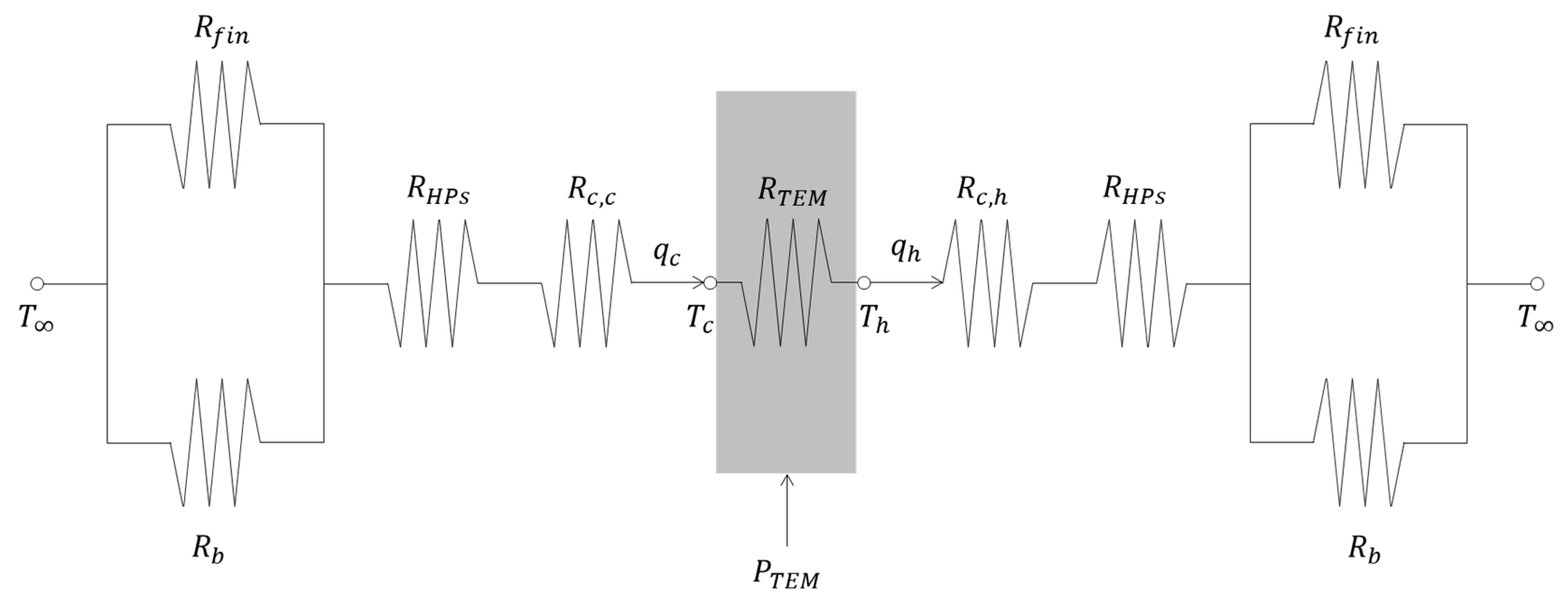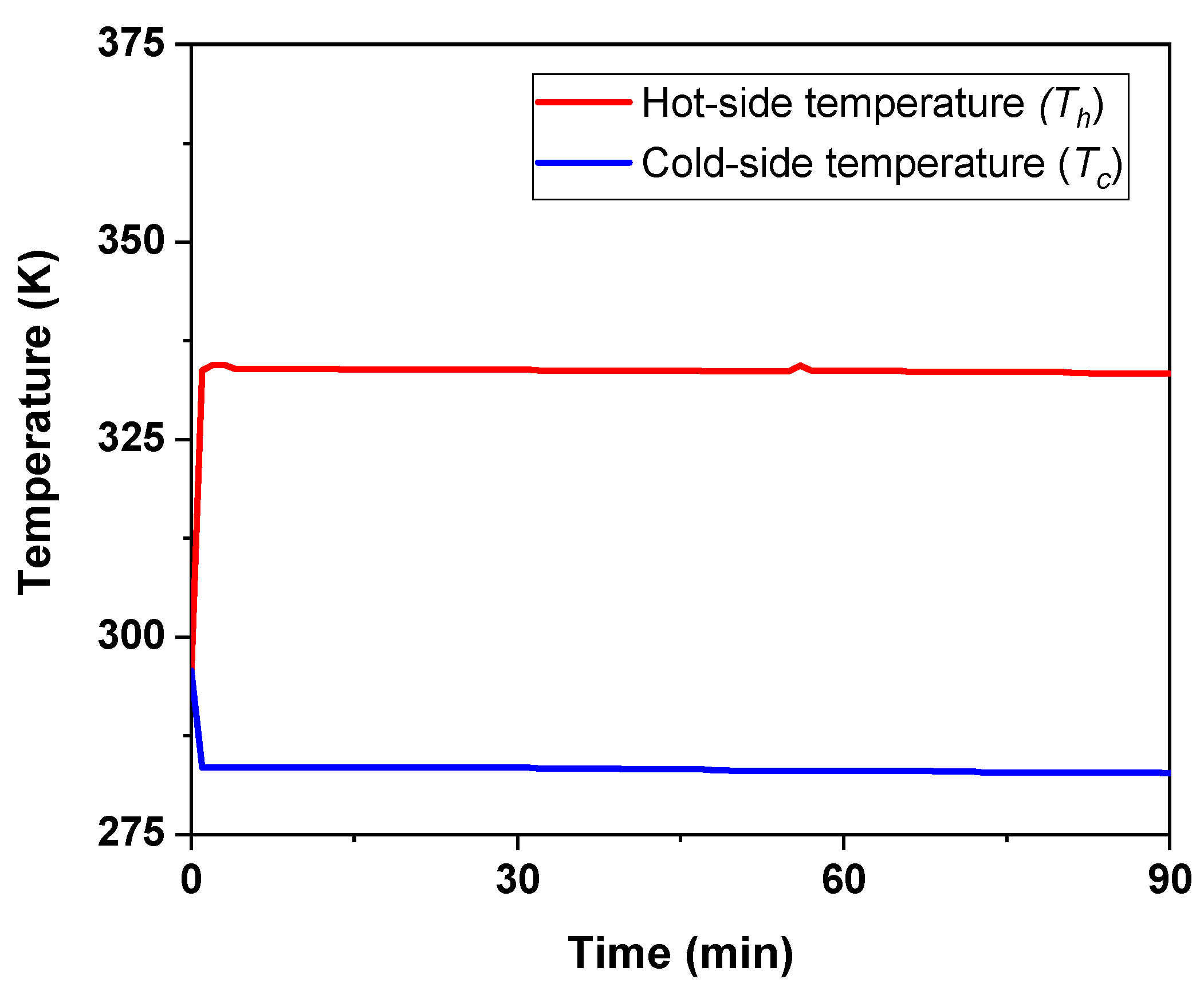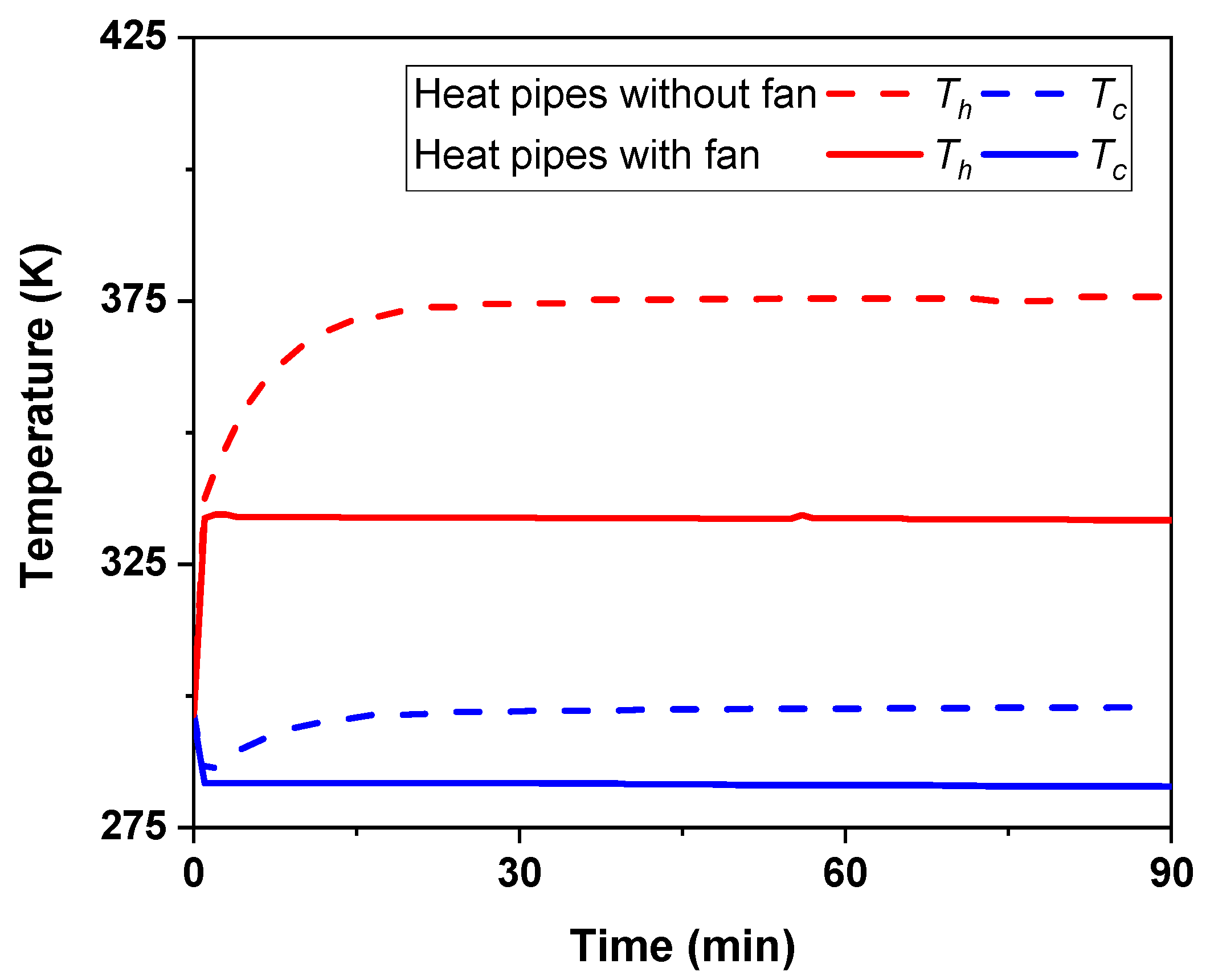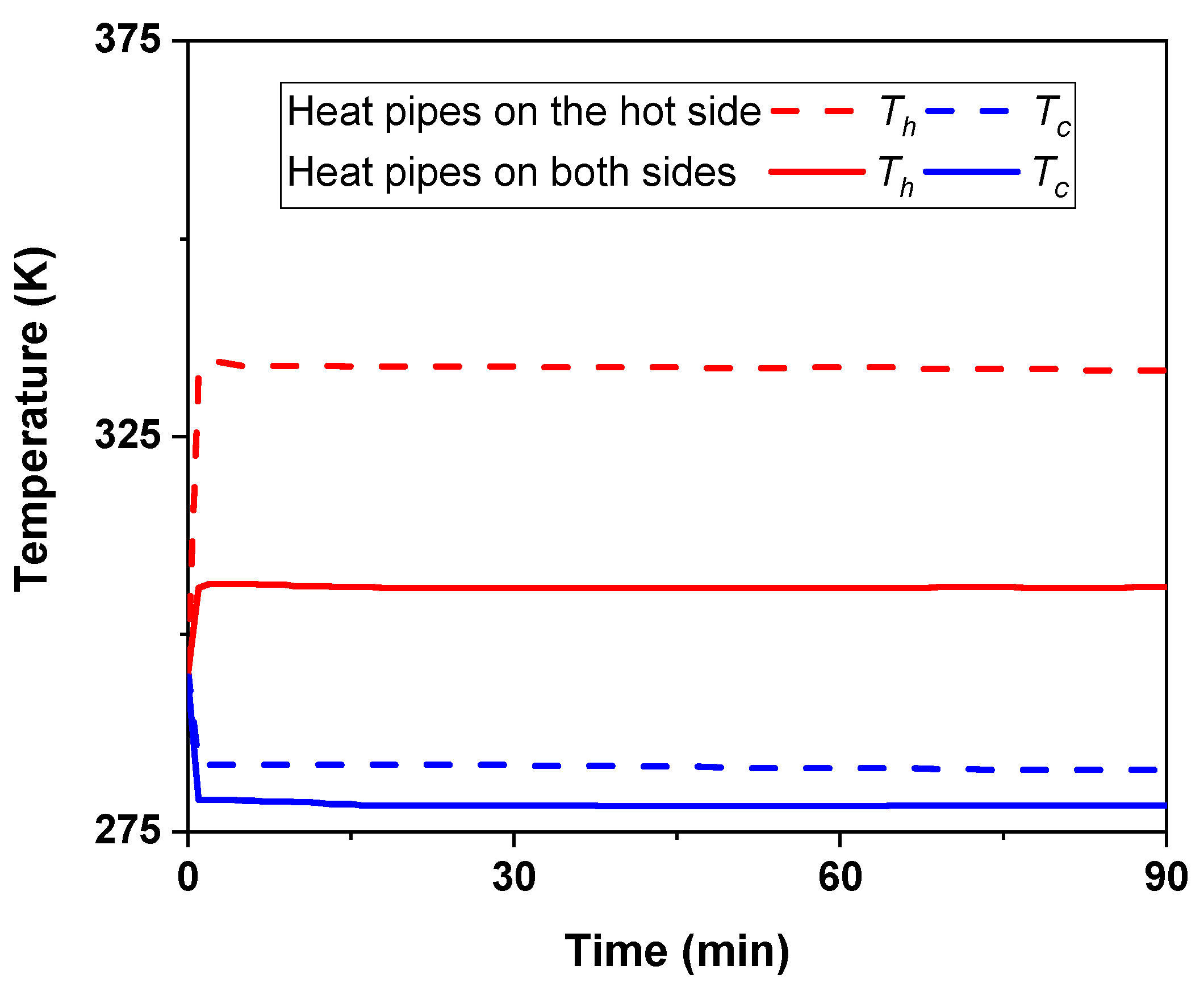Enhanced Performance of a Thermoelectric Module with Heat Pipes for Refrigeration Applications
Abstract
1. Introduction
2. Materials and Methods
3. Heat Transfer Equations
4. Results
4.1. Effects of Boundary Conditions on the TEM Performance
4.2. Characterization of a TEM-Based Cooler with Heat Pipe Assembly
5. Discussion
6. Conclusions
- The optimized configuration from the three boundary conditions included HPs attached to a fan, which yielded a COP of 0.53 at a cooling rate of 26.26 W and a cold-side temperature of 278.5 K. This significant improvement in TEM performance was due to the enhanced heat transfer from the hot side (61.94 W), which reduced the hot-side temperature to 305.6 K.
- Removing the fan from the HPs negatively affected the TEM efficiency because of inadequate heat dissipation from the hot side.
- This study shows that the COP increased from 0.25 to 0.53 as the ΔT decreased from 50.6 K to 27.2 K because a smaller ΔT reduces the heat conduction between the TEM sides, leading to a higher and COP.
- The overall efficiency of the TEM was primarily controlled by the thermal resistance of both sides. According to the thermal resistance analysis, the COP of the TEM increases with a reduction in the thermal resistance on the hot and cold sides, which show minimum values of 0.17 and 0.63 K/W, respectively, for the optimized configuration.
Funding
Data Availability Statement
Acknowledgments
Conflicts of Interest
Abbreviations
| AGHPs | Axially grooved heat pipes [-]; |
| Al | Aluminum [-]; |
| Unfinned surface area of the HPs condenser [m2]; | |
| Fin surface area [m2]; | |
| COP | Coefficient of performance [-]; |
| DC | Direct current [-]; |
| ΔT | Temperature difference between the TEM sides [K]; |
| Convective heat transfer coefficient [W/m2K]; | |
| HPs | Heat pipes [-]; |
| I | Current [A]; |
| Itot | Total electrical current supplied to the cooler system [A]; |
| K | Thermal conductance [W/K]; |
| Number of fins [-]; | |
| PVC | Polyvinyl chloride [-]; |
| P | Applied electrical power to the TEM cooling system [W]; |
| Electric power supplied to the TEM [W]; | |
| Heat transfer rate into the cold side [W]; | |
| Heat transfer rate out of the hot side [W]; | |
| R | Electrical resistance [Ω]; |
| Convective resistance from the unfinned surfaces of the HPs condenser [K/W]; | |
| Thermal contact resistance on the cold side [K/W]; | |
| Thermal contact resistance on the hot side [K/W]; | |
| Thermal resistance of the HPs [K/W]; | |
| Thermal resistance of the fin array [K/W]; | |
| Conduction thermal resistance of the TEM [K/W]; | |
| Hot-side thermal resistance [K/W]; | |
| Cold-side thermal resistance [K/W]; | |
| S | Seebeck coefficient [V/K]; |
| TEM | Thermoelectric module [-]; |
| Cold-side temperature [K]; | |
| Ambient air temperature [K]; | |
| Hot-side temperature [K]; | |
| V | Voltage [V]; |
| Greek symbols | |
| Fin efficiency [-]. | |
References
- Mao, J.; Chen, G.; Ren, Z. Thermoelectric Cooling Materials. Nat. Mater. 2021, 20, 454–461. [Google Scholar] [CrossRef] [PubMed]
- Bell, L.E. Cooling, Heating, Generating Power, and Recovering Waste Heat with Thermoelectric Systems. Science 2008, 321, 1457–1461. [Google Scholar] [CrossRef] [PubMed]
- Min, G.; Rowe, D.M. Experimental Evaluation of Prototype Thermoelectric Domestic-Refrigerators. Appl. Energy 2006, 83, 133–152. [Google Scholar] [CrossRef]
- Tassou, S.A.; Lewis, J.S.; Ge, Y.T.; Hadawey, A.; Chaer, I. A Review of Emerging Technologies for Food Refrigeration Applications. Appl. Therm. Eng. 2010, 30, 263–276. [Google Scholar] [CrossRef]
- Hu, B.; Shi, X.L.; Zou, J.; Chen, Z.G. Thermoelectrics for Medical Applications: Progress, Challenges, and Perspectives. Chem. Eng. J. 2022, 437, 135268. [Google Scholar] [CrossRef]
- Hermes, C.J.L.; Barbosa, J.R. Thermodynamic Comparison of Peltier, Stirling, and Vapor Compression Portable Coolers. Appl. Energy 2012, 91, 51–58. [Google Scholar] [CrossRef]
- Güler, N.F.; Ahiska, R. Design and Testing of a Microprocessor-Controlled Portable Thermoelectric Medical Cooling Kit. Appl. Therm. Eng. 2002, 22, 1271–1276. [Google Scholar] [CrossRef]
- Cai, Y.; Wang, Y.; Liu, D.; Zhao, F.Y. Thermoelectric Cooling Technology Applied in the Field of Electronic Devices: Updated Review on the Parametric Investigations and Model Developments. Appl. Therm. Eng. 2019, 148, 238–255. [Google Scholar] [CrossRef]
- Enescu, D.; Virjoghe, E.O. A Review on Thermoelectric Cooling Parameters and Performance. Renew. Sustain. Energy Rev. 2014, 38, 903–916. [Google Scholar] [CrossRef]
- Astrain, D.; Aranguren, P.; Martínez, A.; Rodríguez, A.; Pérez, M.G. A Comparative Study of Different Heat Exchange Systems in a Thermoelectric Refrigerator and Their Influence on the Efficiency. Appl. Therm. Eng. 2016, 103, 1289–1298. [Google Scholar] [CrossRef]
- Riffat, S.B.; Ma, X. Improving the Coefficient of Performance of Thermoelectric Cooling Systems: A Review. Int. J. Energy Res. 2004, 28, 753–768. [Google Scholar] [CrossRef]
- Liu, Z.; Hu, G.; Wang, J.; Suo, Y.; Ye, Y.; Li, G.; Zhang, Z. Design and Optimization of a Cubic Two-Stage Thermoelectric Cooler for Thermal Performance Enhancement. Energy Convers. Manag. 2022, 271, 116259. [Google Scholar] [CrossRef]
- Zhao, D.; Tan, G.; Yang, L.; Chen, Z.G.; Dargusch, M.S.; Zou, J.; Zhao, D.; Tan, G. A Review of Thermoelectric Cooling: Materials, Modeling and Applications. Appl. Therm. Eng. 2014, 66, 15–24. [Google Scholar] [CrossRef]
- Hu, Y.; Shen, B. Experimental Insights into Thermoelectric Freezer Systems: Feasibility and Efficiency. Energy Convers. Manag. X 2024, 23, 100676. [Google Scholar] [CrossRef]
- Dai, Y.J.; Wang, R.Z.; Ni, L. Experimental Investigation and Analysis on a Thermoelectric Refrigerator Driven by Solar Cells. Sol. Energy Mater. Sol. Cells 2003, 77, 377–391. [Google Scholar] [CrossRef]
- Abdul-Wahab, S.A.; Elkamel, A.; Al-Damkhi, A.M.; Al-Habsi, I.A.; Al-Rubai’ey’, H.S.; Al-Battashi, A.K.; Al-Tamimi, A.R.; Al-Mamari, K.H.; Chutani, M.U. Design and Experimental Investigation of Portable Solar Thermoelectric Refrigerator. Renew. Energy 2009, 34, 30–34. [Google Scholar] [CrossRef]
- Rahman, S.M.A.; Hachicha, A.A.; Ghenai, C.; Saidur, R.; Said, Z. Performance and Life Cycle Analysis of a Novel Portable Solar Thermoelectric Refrigerator. Case Stud. Therm. Eng. 2020, 19, 100599. [Google Scholar] [CrossRef]
- Afshari, F.; Akif Ceviz, M.; Mandev, E.; Yıldız, F. Effect of Heat Exchanger Base Thickness and Cooling Fan on Cooling Performance of Air-To-Air Thermoelectric Refrigerator; Experimental and Numerical Study. Sustain. Energy Technol. Assess. 2022, 52, 102178. [Google Scholar] [CrossRef]
- Çağlar, A. Optimization of Operational Conditions for a Thermoelectric Refrigerator and Its Performance Analysis at Optimum Conditions. Int. J. Refrig. 2018, 96, 70–77. [Google Scholar] [CrossRef]
- He, Y.; Cao, C.; Wu, J.; Chen, G. Investigations on Coupling between Performance and External Operational Conditions for a Semiconductor Refrigeration System. Int. J. Refrig. 2020, 109, 172–179. [Google Scholar] [CrossRef]
- Gökçek, M.; Şahin, F. Experimental Performance Investigation of Minichannel Water Cooled-Thermoelectric Refrigerator. Case Stud. Therm. Eng. 2017, 10, 54–62. [Google Scholar] [CrossRef]
- Abderezzak, B.; Dreepaul, R.K.; Busawon, K.; Chabane, D. Experimental Characterization of a Novel Configuration of Thermoelectric Refrigerator with Integrated Finned Heat Pipes. Int. J. Refrig. 2021, 131, 157–167. [Google Scholar] [CrossRef]
- Ohara, B.; Sitar, R.; Soares, J.; Novisoff, P.; Nunez-Perez, A.; Lee, H. Optimization Strategies for a Portable Thermoelectric Vaccine Refrigeration System in Developing Communities. J. Electron. Mater. 2015, 44, 1614–1626. [Google Scholar] [CrossRef]
- Vián, J.G.G.; Astrain, D. Development of a Thermoelectric Refrigerator with Two-Phase Thermosyphons and Capillary Lift. Appl. Therm. Eng. 2009, 29, 1935–1940. [Google Scholar] [CrossRef]
- Faghri, A. Review and Advances in Heat Pipe Science and Technology. J. Heat Transfer 2012, 134. [Google Scholar] [CrossRef]
- Ku, J. Introduction to Heat Pipes. In Proceedings of the Thermal Fluids and Analysis Workshop (TFAWS) 2015, Silver Spring, MD, USA, 3–7 August 2015; p. 74. [Google Scholar]
- Riffat, S.B.; Omer, S.A.; Ma, X. A Novel Thermoelectric Refrigeration System Employing Heat Pipes and a Phase Change Material: An Experimental Investigation. Renew. Energy 2001, 23, 313–323. [Google Scholar] [CrossRef]
- Liang, K.; Li, Z.; Chen, M.; Jiang, H. Comparisons between Heat Pipe, Thermoelectric System, and Vapour Compression Refrigeration System for Electronics Cooling. Appl. Therm. Eng. 2019, 146, 260–267. [Google Scholar] [CrossRef]
- Liu, Y.; Su, Y. Experimental Investigations on COPs of Thermoelectric Module Frosting Systems with Various Hot Side Cooling Methods. Appl. Therm. Eng. 2018, 144, 747–756. [Google Scholar] [CrossRef]
- Siddique, A.R.M.; Bozorgi, M.; Venkateshwar, K.; Tasnim, S.; Mahmud, S. Phase Change Material-Enhanced Solid-State Thermoelectric Cooling Technology for Food Refrigeration and Storage Applications. J. Energy Storage 2023, 60, 106569. [Google Scholar] [CrossRef]
- Fenton, E.; Bozorgi, M.; Tasnim, S.; Mahmud, S. Solar-Powered Thermoelectric Refrigeration with Integrated Phase Change Material: An Experimental Approach to Food Storage. J. Energy Storage 2024, 79, 110247. [Google Scholar] [CrossRef]
- Kaiprath, J.; Kishor Kumar, V.V. A Review on Solar Photovoltaic-Powered Thermoelectric Coolers, Performance Enhancements, and Recent Advances. Int. J. Air Cond. Refrig. 2023, 31, 6. [Google Scholar] [CrossRef]
- Alrefae, M.A. Influence of Heat Dissipation on the Performance of a Thermoelectric Module. In Proceedings of the International Heat Transfer Conference 17, Cape Town, South Africa, 14–18 August 2023; Begell House Inc.: Danbury, CT, USA, 2023; p. ID: 575. [Google Scholar]
- Cai, Y.; Liu, D.; Zhao, F.Y.; Tang, J.F. Performance Analysis and Assessment of Thermoelectric Micro Cooler for Electronic Devices. Energy Convers. Manag. 2016, 124, 203–211. [Google Scholar] [CrossRef]
- Bergman, T.L.; Lavine, A.S.; Incropera, F.P.; Dewitt, D.P. Fundamentals of Heat and Mass Transfer, 7th ed.; Wiley: Hoboken, NJ, USA, 2011. [Google Scholar]
- Zeghari, K.; Louahlia, H. Flat Miniature Heat Pipe with Sintered Porous Wick Structure: Experimental and Mathematical Studies. Int. J. Heat Mass Transf. 2020, 158, 120021. [Google Scholar] [CrossRef]
- Poplaski, L.M.; Faghri, A.; Bergman, T.L. Analysis of Internal and External Thermal Resistances of Heat Pipes Including Fins Using a Three-Dimensional Numerical Simulation. Int. J. Heat Mass Transf. 2016, 102, 455–469. [Google Scholar] [CrossRef]
- Sun, X.; Zhang, L.; Liao, S. Performance of a Thermoelectric Cooling System Integrated with a Gravity-Assisted Heat Pipe for Cooling Electronics. Appl. Therm. Eng. 2017, 116, 433–444. [Google Scholar] [CrossRef]
- Sun, X.; Ling, L.; Liao, S.; Chu, Y.; Fan, S.; Mo, Y. A Thermoelectric Cooler Coupled with a Gravity-Assisted Heat Pipe: An Analysis from Heat Pipe Perspective. Energy Convers. Manag. 2018, 155, 230–242. [Google Scholar] [CrossRef]
- Aranguren, P.; DiazDeGarayo, S.; Martínez, A.; Araiz, M.; Astrain, D. Heat Pipes Thermal Performance for a Reversible Thermoelectric Cooler-Heat Pump for a NZEB. Energy Build. 2019, 187, 163–172. [Google Scholar] [CrossRef]
- Park, S.J.; Bang, K.M.; Kim, B.; Ziolkowski, P.; Jeong, J.R.; Jin, H. Adaptive Thermoelectric Cooling System for Energy-Efficient Local and Transient Heat Management. Appl. Therm. Eng. 2022, 216, 119060. [Google Scholar] [CrossRef]
- Russel, M.K.; Ewing, D.; Ching, C.Y. Characterization of a Thermoelectric Cooler Based Thermal Management System under Different Operating Conditions. Appl. Therm. Eng. 2013, 50, 652–659. [Google Scholar] [CrossRef]
- Phelan, P.E.; Chiriac, V.A.; Tom Lee, T.Y. Current and Future Miniature Refrigeration Cooling Technologies for High Power Microelectronics. IEEE Trans. Compon. Packag. Technol. 2002, 25, 356–365. [Google Scholar] [CrossRef]
- Chang, Y.W.; Chang, C.C.; Ke, M.T.; Chen, S.L. Thermoelectric Air-Cooling Module for Electronic Devices. Appl. Therm. Eng. 2009, 29, 2731–2737. [Google Scholar] [CrossRef]
- Zhang, H.Y.; Mui, Y.C.; Tarin, M. Analysis of Thermoelectric Cooler Performance for High Power Electronic Packages. Appl. Therm. Eng. 2010, 30, 561–568. [Google Scholar] [CrossRef]
- Choi, J.; Jeong, M.; Yoo, J.; Seo, M. A New CPU Cooler Design Based on an Active Cooling Heatsink Combined with Heat Pipes. Appl. Therm. Eng. 2012, 44, 50–56. [Google Scholar] [CrossRef]








| Configuration | (K) | (K) | ΔT (K) | (W) | (W) | COP | (K/W) | (K/W) |
|---|---|---|---|---|---|---|---|---|
| Hot side: HPs without fan Cold side: heat exchange (or cooling plate) | 376.7 ± 2.6 | 298.1 ± 2.6 | 78.6 ± 5.2 | 18.69 ±0.44 | −6.78 ± 0.49 | - | 4.32 ± 0.10 | 0.33 ± 0.03 |
| Hot side: HPs with fan Cold side: heat exchange (or cooling plate) | 333.1 ± 0.4 | 282.4 ± 0.3 | 50.6 ± 0.7 | 42.48 ± 0.09 | 11.10 ± 0.13 | 0.25 ± 0.01 | 0.87 ± 0.01 | 1.22 ± 0.03 |
| Hot side: HPs with fan Cold side: HPs with fan | 305.6 ± 1.3 | 278.5 ± 0.3 | 27.2 ± 1.6 | 61.94 ± 0.32 | 26.26 ± 0.54 | 0.53 ± 0.01 | 0.17 ± 0.02 | 0.63 ± 0.03 |
Disclaimer/Publisher’s Note: The statements, opinions and data contained in all publications are solely those of the individual author(s) and contributor(s) and not of MDPI and/or the editor(s). MDPI and/or the editor(s) disclaim responsibility for any injury to people or property resulting from any ideas, methods, instructions or products referred to in the content. |
© 2025 by the author. Licensee MDPI, Basel, Switzerland. This article is an open access article distributed under the terms and conditions of the Creative Commons Attribution (CC BY) license (https://creativecommons.org/licenses/by/4.0/).
Share and Cite
Alrefae, M.A. Enhanced Performance of a Thermoelectric Module with Heat Pipes for Refrigeration Applications. Energies 2025, 18, 2426. https://doi.org/10.3390/en18102426
Alrefae MA. Enhanced Performance of a Thermoelectric Module with Heat Pipes for Refrigeration Applications. Energies. 2025; 18(10):2426. https://doi.org/10.3390/en18102426
Chicago/Turabian StyleAlrefae, Majed A. 2025. "Enhanced Performance of a Thermoelectric Module with Heat Pipes for Refrigeration Applications" Energies 18, no. 10: 2426. https://doi.org/10.3390/en18102426
APA StyleAlrefae, M. A. (2025). Enhanced Performance of a Thermoelectric Module with Heat Pipes for Refrigeration Applications. Energies, 18(10), 2426. https://doi.org/10.3390/en18102426





